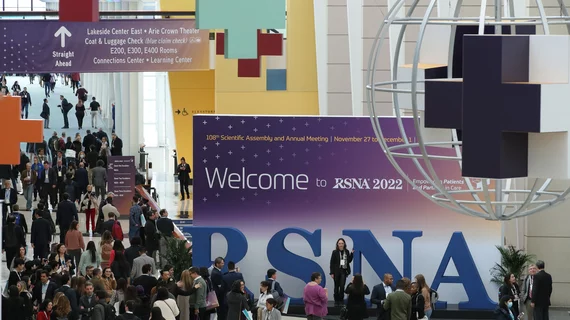RSNA shows conference attendance, radiology research still recovering from COVID
In-person attendance for RSNA 2022 dipped by more than 11,000 compared with the last conference held before the global descent of the COVID-19 pandemic.
The falloff was around 23%, from 49,310 physical attendees in 2019 to approximately 38,000 this year.
In announcing the latest conference statistics Dec. 14, RSNA calls 2022’s physical foot traffic “robust” and notes other signs of post-pandemic rebound.
These included more than 900 scientific papers in 19 subspecialties, more than 1,300 scientific posters, 300-plus education courses and more than 1,450 education exhibits.
Further, RSNA 2022’s technical exhibits occupied 364,000 square feet and featured 644 exhibitors, including 124 first-time RSNA exhibitors, the organization reports.
RSNA adds that AI again enjoyed a high-profile presence across the event, “playing a key role in hundreds of research papers, courses and education exhibits” while abounding in booths throughout the exhibitor halls.
“AI is proving to be an important tool to assist radiologists in disease detection and improve radiology workflow,” RSNA executive director Mark Watson says in a Dec. 14 news release. “RSNA will continue to provide our attendees a wide variety of AI sessions and showcase AI-based solutions on the exhibit floor.”
Full news release here.
Radiology Research: ‘There’s a Smaller Funding Pot Now’
RSNA has separately posted a news update of research published in Radiology during COVID’s initial U.S. surge in the spring of 2020.
In that study, Achala Vagal, MD, of the University of Cincinnati and co-authors explored ways the “rapid suspension of radiology research operations has created numerous challenges with short- and long-term implications” [1].
In the news item, posted Dec. 15, RSNA speaks with the study’s authors and reports that radiology research has resumed, albeit “not at the same pre-pandemic pace.”
“In clinical trials all around the country, the common theme is that it’s hard to find coordinators,” Vagal observes. “Subject enrollment is picking up, but one coordinator could be managing seven to eight trials, making it difficult to identify participants who fit the inclusion criteria for each trial.”
“There’s a smaller funding pot now, and imaging research can seem expensive compared to other clinical diagnostic research,” adds Vicky Goh, MD, of King’s College London. “There is a lack of funding for new hires, even for replacement posts. If the amount of personnel needed to carry out a project isn’t there, that research is stalled.”

